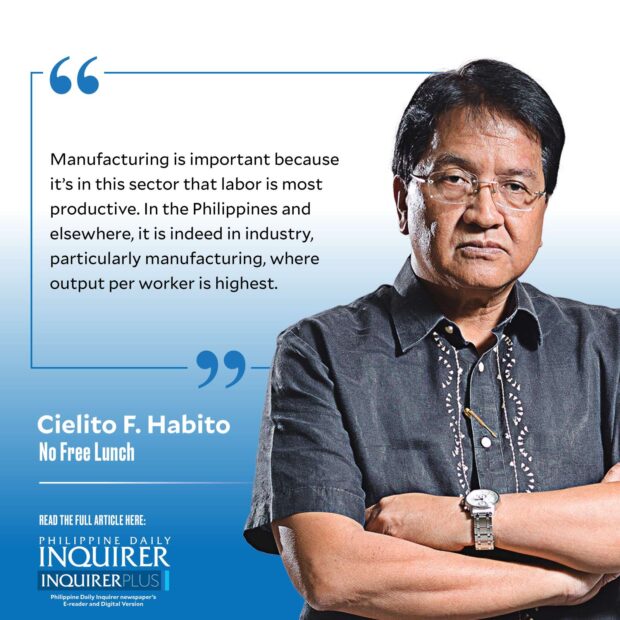Wanted: A manufacturing boost

All economies that are rich today have, at some point in the last 40 years, enjoyed high manufacturing employment shares,” Spanish economist Dr. Jesus Felipe noted in a 2014 Asian Development Bank paper. This and many other studies through the years have consistently shown that the manufacturing sector is critical for an economy to achieve high-income status; that is, an economy must industrialize if it is to become economically developed. By international experience, this implies attaining at least a 20-percent share of manufacturing in the economy’s total output and incomes, measured by gross domestic product or GDP. Our manufacturing share now is only 18.3 percent, against 23.4, 24.8, and 27 percent in Malaysia, Vietnam, and Thailand, respectively.
Manufacturing is important because it’s in this sector that labor is most productive. In the Philippines and elsewhere, it is indeed in industry, particularly manufacturing, where output per worker is highest. In 2022, each worker in manufacturing contributed an average of P1.01 million to our GDP, as against P467,029 in services and only P178,843 in agriculture, fishery, and forestry. Not only is labor productivity in manufacturing much higher; but it is also in manufacturing where worker productivity grows faster over time. Felipe cites the observation by Harvard economist Dani Rodrik that “economies that create many manufacturing jobs grow faster because manufacturing has an ‘escalator’ quality—labor productivity in manufacturing industries rises rapidly …”
In the 1990s, the Philippine economy saw renewed growth under the dynamic leadership of President Fidel V. Ramos, who was seen as the “greatest salesman” for the Philippine economy then. He provided an environment that attracted large manufacturing investments, and there were many anecdotes of satisfied foreign investors attesting how their Filipino workers were even more productive than in their similar factories elsewhere. Even so, it was the services sector that grew the fastest in those boom years before the Asian financial crisis flattened the economies of the region. It was also the time when China was rapidly becoming the “factory of the world,” attracting a dominant part of manufacturing investments at the time. Local pundits described our economy to be “leapfrogging” to an economy dominated by services, coming from one dominated by agriculture in past decades, noting how the economy had bypassed the industrialization stage typical of other economies’ development stories—as if that was a good thing. Hindsight now tells us that it was not, as it led to an economic growth that I was later to describe for many years as “narrow, shallow, and hollow,” benefitting a limited segment of our economy and society, and mostly in Metro Manila and surrounding regions.
A turning point came in 2010 when the new national leadership appeared to boost confidence in the economy from both domestic and foreign investors. Manufacturing in subsequent years grew significantly faster than the overall economy did, implying that manufacturing was pulling up the growth of the economy as a whole. Between 2010 and 2017, the manufacturing sector grew at an annual average of 7.8 percent, well above the average annual GDP growth rate of 6.3 percent in the same period. In direct contrast, the five-year period from 2004-2008 saw manufacturing grow at an annual average of 4.6 percent, against overall GDP growth of 5.7 percent (2009 is excluded as it was an abnormal year when the world financial crisis again flattened many economies, including ours). In that period, manufacturing was effectively a drag on the overall economy. It’s no coincidence that we saw the fastest decline in income poverty from 2012 to 2015, a five-percentage-point drop from 26 to 21 percent, which was the largest drop seen within a three-year period between survey years for the Family Income and Expenditures Survey, the main basis for our official poverty data. There’s good reason to believe that the exceptional surge in manufacturing after 2010 was instrumental to this.
But things have changed again. From 2018 to 2022 (excluding the abnormal pandemic year of 2020), average annual manufacturing growth (5.5 percent) is again slower than that of the overall economy (6.4 percent). In the first three quarters of 2023, manufacturing grew by only 1.5 percent, far slower than overall GDP growth of 5.5 percent. This calls for extraordinary efforts to boost the performance of the sector and restore the trend we saw in 2010-2017. What we need now is a stronger agriculture sector to feed into manufacturing, and attract much more manufacturing investments than we’ve managed to get lately. I’ve written much on this, and it’s time for our economic managers to roll up their sleeves and get down to the serious work needed.




















